heating FIAT DUCATO 2018 Owner handbook (in English)
[x] Cancel search | Manufacturer: FIAT, Model Year: 2018, Model line: DUCATO, Model: FIAT DUCATO 2018Pages: 304, PDF Size: 14.93 MB
Page 55 of 304
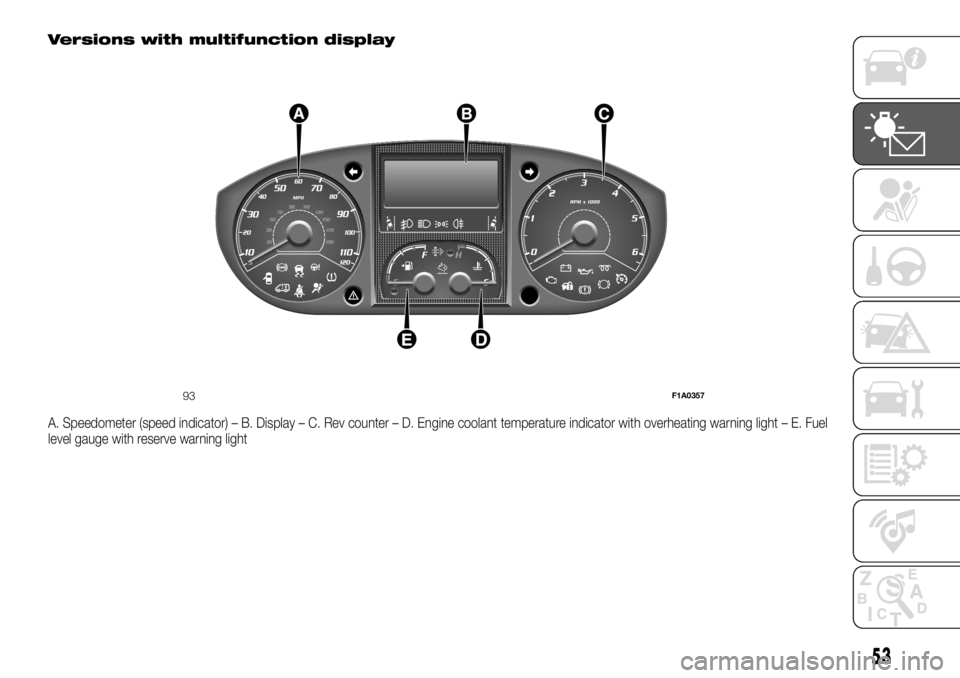
Versions with multifunction display
A. Speedometer (speed indicator) – B. Display – C. Rev counter – D. Engine coolant temperature indicator with overheating warning light – E. Fuel
level gauge with reserve warning light
93F1A0357
53
Page 56 of 304
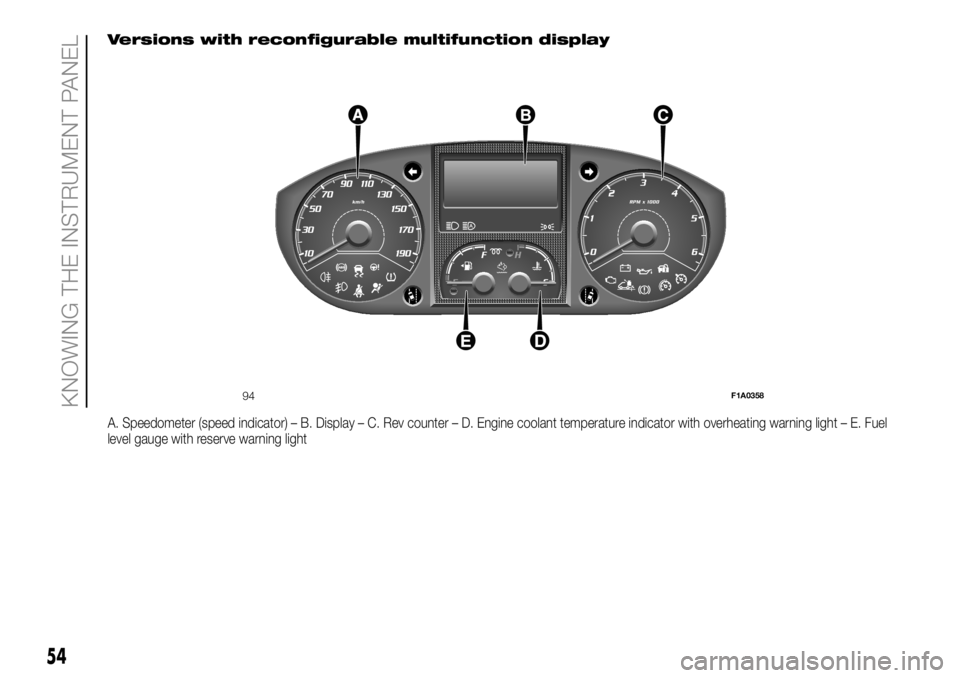
Versions with reconfigurable multifunction display
A. Speedometer (speed indicator) – B. Display – C. Rev counter – D. Engine coolant temperature indicator with overheating warning light – E. Fuel
level gauge with reserve warning light
94F1A0358
54
KNOWING THE INSTRUMENT PANEL
Page 57 of 304
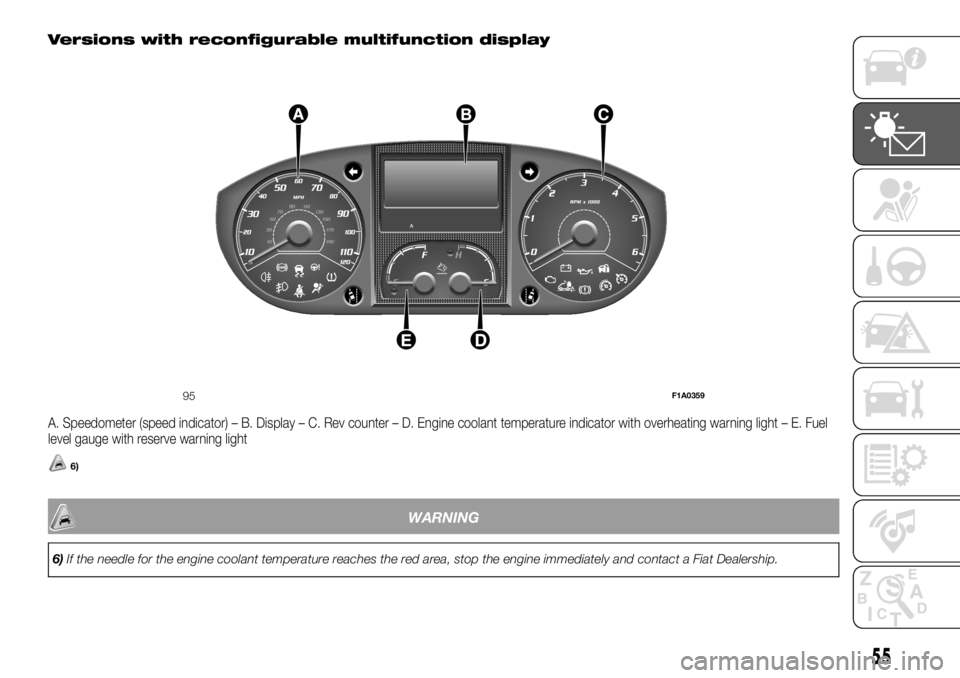
Versions with reconfigurable multifunction display
A. Speedometer (speed indicator) – B. Display – C. Rev counter – D. Engine coolant temperature indicator with overheating warning light – E. Fuel
level gauge with reserve warning light
6)
WARNING
6)If the needle for the engine coolant temperature reaches the red area, stop the engine immediately and contact a Fiat Dealership.
95F1A0359
55
Page 71 of 304
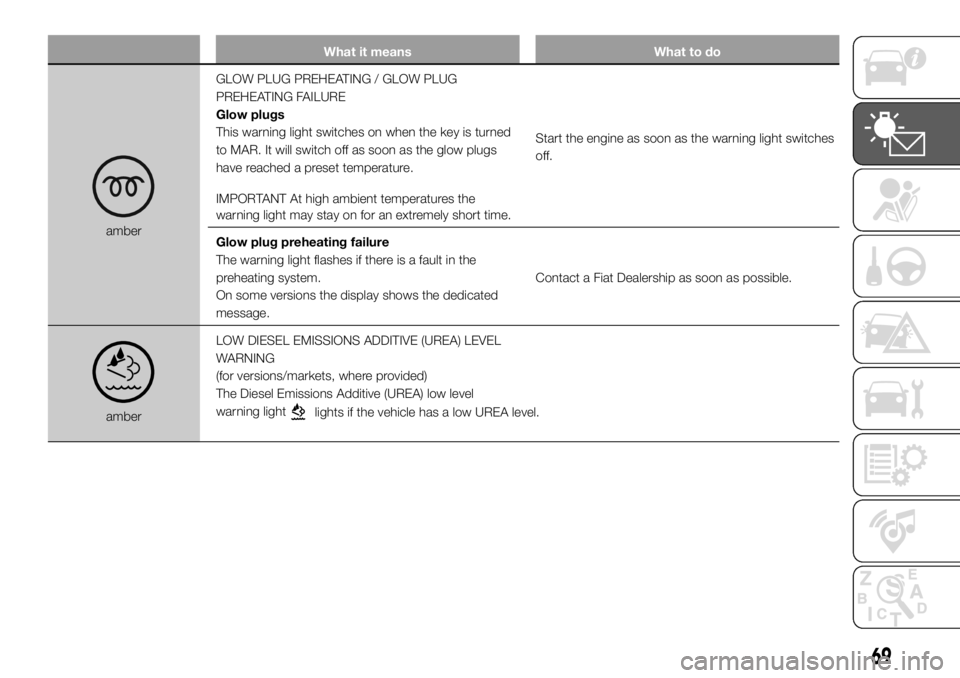
What it means What to do
amberGLOW PLUG PREHEATING / GLOW PLUG
PREHEATING FAILURE
Glow plugs
This warning light switches on when the key is turned
to MAR. It will switch off as soon as the glow plugs
have reached a preset temperature.
IMPORTANT At high ambient temperatures the
warning light may stay on for an extremely short time.Start the engine as soon as the warning light switches
off.
Glow plug preheating failure
The warning light flashes if there is a fault in the
preheating system.
On some versions the display shows the dedicated
message.Contact a Fiat Dealership as soon as possible.
amberLOW DIESEL EMISSIONS ADDITIVE (UREA) LEVEL
WARNING
(for versions/markets, where provided)
The Diesel Emissions Additive (UREA) low level
warning lightlights if the vehicle has a low UREA level.
69
Page 85 of 304
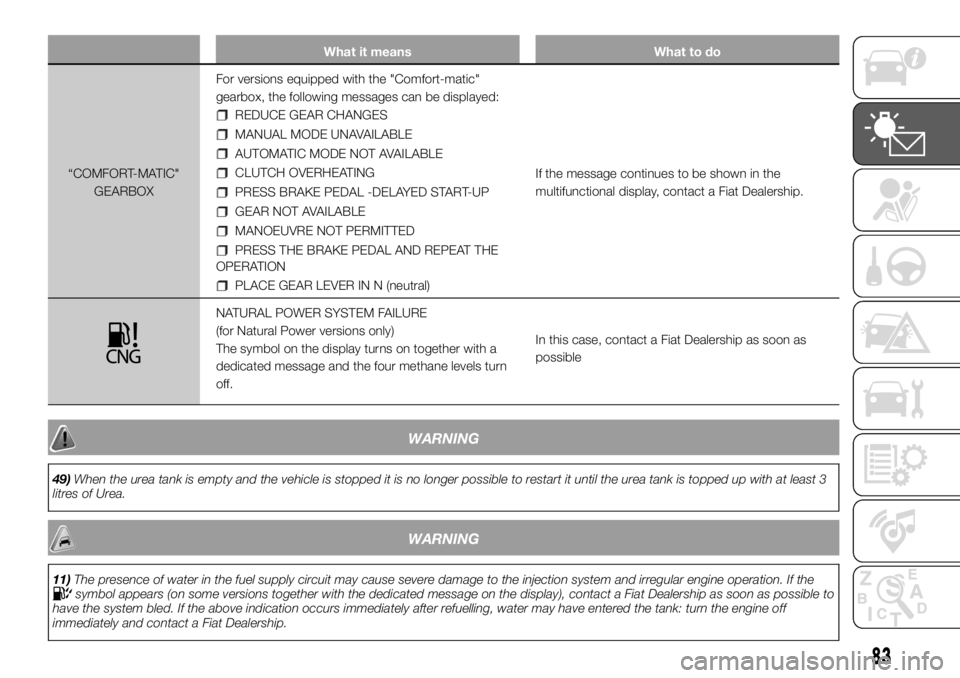
What it means What to do
“COMFORT-MATIC"
GEARBOXFor versions equipped with the "Comfort-matic"
gearbox, the following messages can be displayed:
REDUCE GEAR CHANGES
MANUAL MODE UNAVAILABLE
AUTOMATIC MODE NOT AVAILABLE
CLUTCH OVERHEATING
PRESS BRAKE PEDAL -DELAYED START-UP
GEAR NOT AVAILABLE
MANOEUVRE NOT PERMITTED
PRESS THE BRAKE PEDAL AND REPEAT THE
OPERATION
PLACE GEAR LEVER IN N (neutral)If the message continues to be shown in the
multifunctional display, contact a Fiat Dealership.
NATURAL POWER SYSTEM FAILURE
(for Natural Power versions only)
The symbol on the display turns on together with a
dedicated message and the four methane levels turn
off.In this case, contact a Fiat Dealership as soon as
possible
WARNING
49)When the urea tank is empty and the vehicle is stopped it is no longer possible to restart it until the urea tank is topped up with at least 3
litres of Urea.
WARNING
11)The presence of water in the fuel supply circuit may cause severe damage to the injection system and irregular engine operation. If thesymbol appears (on some versions together with the dedicated message on the display), contact a Fiat Dealership as soon as possible to
have the system bled. If the above indication occurs immediately after refuelling, water may have entered the tank: turn the engine off
immediately and contact a Fiat Dealership.
83
Page 90 of 304
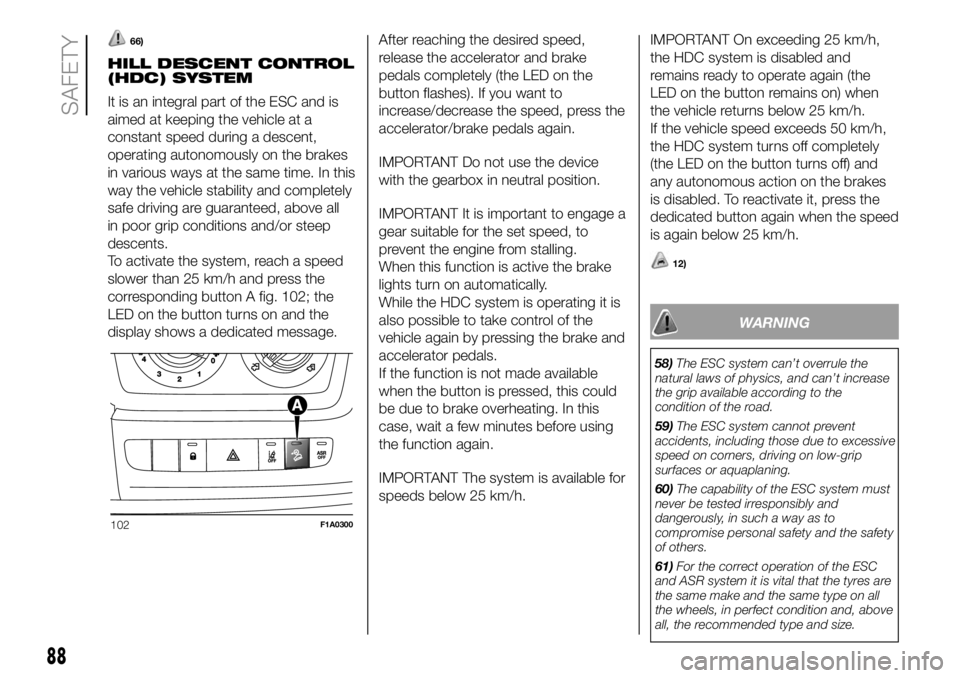
66)
HILL DESCENT CONTROL
(HDC) SYSTEM
It is an integral part of the ESC and is
aimed at keeping the vehicle at a
constant speed during a descent,
operating autonomously on the brakes
in various ways at the same time. In this
way the vehicle stability and completely
safe driving are guaranteed, above all
in poor grip conditions and/or steep
descents.
To activate the system, reach a speed
slower than 25 km/h and press the
corresponding button A fig. 102; the
LED on the button turns on and the
display shows a dedicated message.After reaching the desired speed,
release the accelerator and brake
pedals completely (the LED on the
button flashes). If you want to
increase/decrease the speed, press the
accelerator/brake pedals again.
IMPORTANT Do not use the device
with the gearbox in neutral position.
IMPORTANT It is important to engage a
gear suitable for the set speed, to
prevent the engine from stalling.
When this function is active the brake
lights turn on automatically.
While the HDC system is operating it is
also possible to take control of the
vehicle again by pressing the brake and
accelerator pedals.
If the function is not made available
when the button is pressed, this could
be due to brake overheating. In this
case, wait a few minutes before using
the function again.
IMPORTANT The system is available for
speeds below 25 km/h.IMPORTANT On exceeding 25 km/h,
the HDC system is disabled and
remains ready to operate again (the
LED on the button remains on) when
the vehicle returns below 25 km/h.
If the vehicle speed exceeds 50 km/h,
the HDC system turns off completely
(the LED on the button turns off) and
any autonomous action on the brakes
is disabled. To reactivate it, press the
dedicated button again when the speed
is again below 25 km/h.
12)
WARNING
58)The ESC system can’t overrule the
natural laws of physics, and can’t increase
the grip available according to the
condition of the road.
59)The ESC system cannot prevent
accidents, including those due to excessive
speed on corners, driving on low-grip
surfaces or aquaplaning.
60)The capability of the ESC system must
never be tested irresponsibly and
dangerously, in such a way as to
compromise personal safety and the safety
of others.
61)For the correct operation of the ESC
and ASR system it is vital that the tyres are
the same make and the same type on all
the wheels, in perfect condition and, above
all, the recommended type and size.
102F1A0300
88
SAFETY
Page 93 of 304
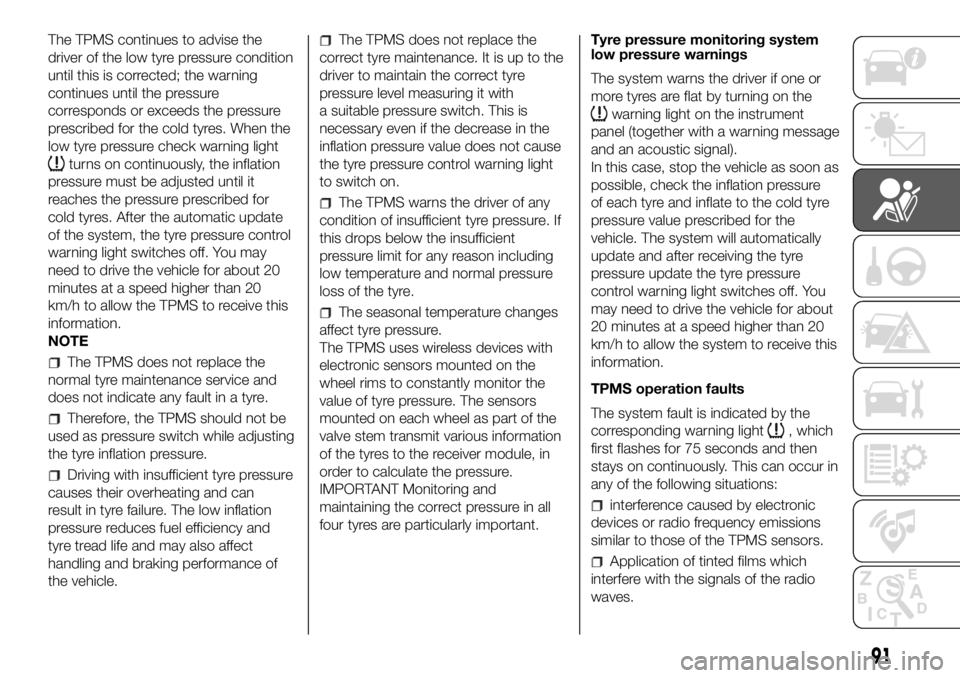
The TPMS continues to advise the
driver of the low tyre pressure condition
until this is corrected; the warning
continues until the pressure
corresponds or exceeds the pressure
prescribed for the cold tyres. When the
low tyre pressure check warning light
turns on continuously, the inflation
pressure must be adjusted until it
reaches the pressure prescribed for
cold tyres. After the automatic update
of the system, the tyre pressure control
warning light switches off. You may
need to drive the vehicle for about 20
minutes at a speed higher than 20
km/h to allow the TPMS to receive this
information.
NOTE
The TPMS does not replace the
normal tyre maintenance service and
does not indicate any fault in a tyre.
Therefore, the TPMS should not be
used as pressure switch while adjusting
the tyre inflation pressure.
Driving with insufficient tyre pressure
causes their overheating and can
result in tyre failure. The low inflation
pressure reduces fuel efficiency and
tyre tread life and may also affect
handling and braking performance of
the vehicle.
The TPMS does not replace the
correct tyre maintenance. It is up to the
driver to maintain the correct tyre
pressure level measuring it with
a suitable pressure switch. This is
necessary even if the decrease in the
inflation pressure value does not cause
the tyre pressure control warning light
to switch on.
The TPMS warns the driver of any
condition of insufficient tyre pressure. If
this drops below the insufficient
pressure limit for any reason including
low temperature and normal pressure
loss of the tyre.
The seasonal temperature changes
affect tyre pressure.
The TPMS uses wireless devices with
electronic sensors mounted on the
wheel rims to constantly monitor the
value of tyre pressure. The sensors
mounted on each wheel as part of the
valve stem transmit various information
of the tyres to the receiver module, in
order to calculate the pressure.
IMPORTANT Monitoring and
maintaining the correct pressure in all
four tyres are particularly important.Tyre pressure monitoring system
low pressure warnings
The system warns the driver if one or
more tyres are flat by turning on the
warning light on the instrument
panel (together with a warning message
and an acoustic signal).
In this case, stop the vehicle as soon as
possible, check the inflation pressure
of each tyre and inflate to the cold tyre
pressure value prescribed for the
vehicle. The system will automatically
update and after receiving the tyre
pressure update the tyre pressure
control warning light switches off. You
may need to drive the vehicle for about
20 minutes at a speed higher than 20
km/h to allow the system to receive this
information.
TPMS operation faults
The system fault is indicated by the
corresponding warning light
, which
first flashes for 75 seconds and then
stays on continuously. This can occur in
any of the following situations:
interference caused by electronic
devices or radio frequency emissions
similar to those of the TPMS sensors.
Application of tinted films which
interfere with the signals of the radio
waves.
91
Page 102 of 304
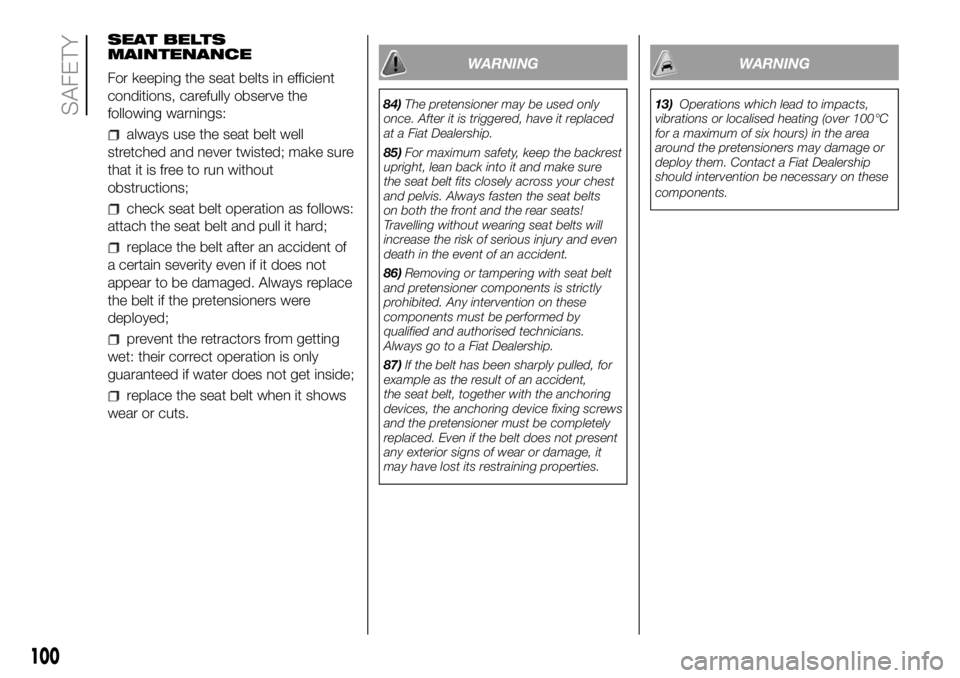
SEAT BELTS
MAINTENANCE
For keeping the seat belts in efficient
conditions, carefully observe the
following warnings:
always use the seat belt well
stretched and never twisted; make sure
that it is free to run without
obstructions;
check seat belt operation as follows:
attach the seat belt and pull it hard;
replace the belt after an accident of
a certain severity even if it does not
appear to be damaged. Always replace
the belt if the pretensioners were
deployed;
prevent the retractors from getting
wet: their correct operation is only
guaranteed if water does not get inside;
replace the seat belt when it shows
wear or cuts.
WARNING
84)The pretensioner may be used only
once. After it is triggered, have it replaced
at a Fiat Dealership.
85)For maximum safety, keep the backrest
upright, lean back into it and make sure
the seat belt fits closely across your chest
and pelvis. Always fasten the seat belts
on both the front and the rear seats!
Travelling without wearing seat belts will
increase the risk of serious injury and even
death in the event of an accident.
86)Removing or tampering with seat belt
and pretensioner components is strictly
prohibited. Any intervention on these
components must be performed by
qualified and authorised technicians.
Always go to a Fiat Dealership.
87)If the belt has been sharply pulled, for
example as the result of an accident,
the seat belt, together with the anchoring
devices, the anchoring device fixing screws
and the pretensioner must be completely
replaced. Even if the belt does not present
any exterior signs of wear or damage, it
may have lost its restraining properties.
WARNING
13)Operations which lead to impacts,
vibrations or localised heating (over 100°C
for a maximum of six hours) in the area
around the pretensioners may damage or
deploy them. Contact a Fiat Dealership
should intervention be necessary on these
components.
100
SAFETY
Page 121 of 304
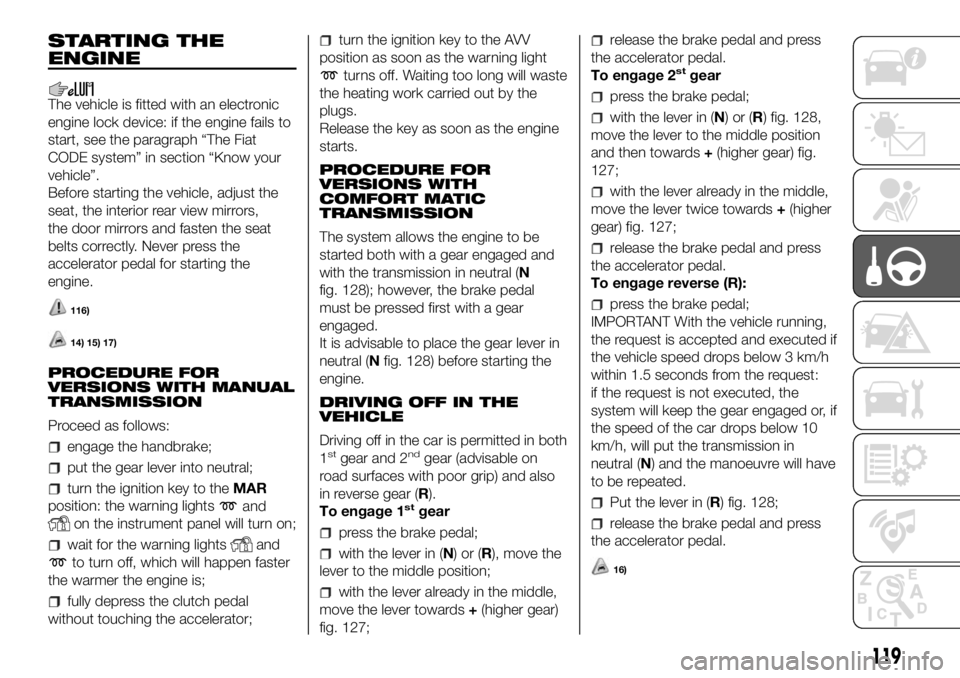
STARTING THE
ENGINE
The vehicle is fitted with an electronic
engine lock device: if the engine fails to
start, see the paragraph “The Fiat
CODE system” in section “Know your
vehicle”.
Before starting the vehicle, adjust the
seat, the interior rear view mirrors,
the door mirrors and fasten the seat
belts correctly. Never press the
accelerator pedal for starting the
engine.
116)
14) 15) 17)
PROCEDURE FOR
VERSIONS WITH MANUAL
TRANSMISSION
Proceed as follows:
engage the handbrake;
put the gear lever into neutral;
turn the ignition key to theMAR
position: the warning lights
and
on the instrument panel will turn on;
wait for the warning lightsand
to turn off, which will happen faster
the warmer the engine is;
fully depress the clutch pedal
without touching the accelerator;
turn the ignition key to the AVV
position as soon as the warning light
turns off. Waiting too long will waste
the heating work carried out by the
plugs.
Release the key as soon as the engine
starts.
PROCEDURE FOR
VERSIONS WITH
COMFORT MATIC
TRANSMISSION
The system allows the engine to be
started both with a gear engaged and
with the transmission in neutral (N
fig. 128); however, the brake pedal
must be pressed first with a gear
engaged.
It is advisable to place the gear lever in
neutral (Nfig. 128) before starting the
engine.
DRIVING OFF IN THE
VEHICLE
Driving off in the car is permitted in both
1
stgear and 2ndgear (advisable on
road surfaces with poor grip) and also
in reverse gear (R).
To engage 1
stgear
press the brake pedal;
with the lever in (N)or(R), move the
lever to the middle position;
with the lever already in the middle,
move the lever towards+(higher gear)
fig. 127;
release the brake pedal and press
the accelerator pedal.
To engage 2
stgear
press the brake pedal;
with the lever in (N)or(R) fig. 128,
move the lever to the middle position
and then towards+(higher gear) fig.
127;
with the lever already in the middle,
move the lever twice towards+(higher
gear) fig. 127;
release the brake pedal and press
the accelerator pedal.
To engage reverse (R):
press the brake pedal;
IMPORTANT With the vehicle running,
the request is accepted and executed if
the vehicle speed drops below 3 km/h
within 1.5 seconds from the request:
if the request is not executed, the
system will keep the gear engaged or, if
the speed of the car drops below 10
km/h, will put the transmission in
neutral (N) and the manoeuvre will have
to be repeated.
Put the lever in (R) fig. 128;
release the brake pedal and press
the accelerator pedal.
16)
119
Page 122 of 304
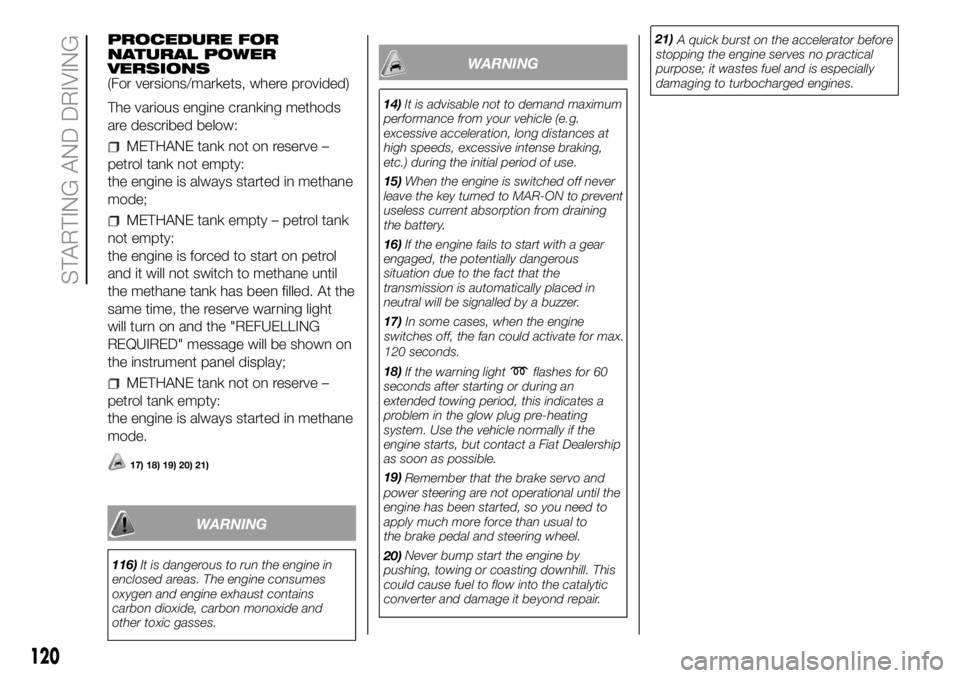
PROCEDURE FOR
NATURAL POWER
VERSIONS
(For versions/markets, where provided)
The various engine cranking methods
are described below:
METHANE tank not on reserve –
petrol tank not empty:
the engine is always started in methane
mode;
METHANE tank empty – petrol tank
not empty:
the engine is forced to start on petrol
and it will not switch to methane until
the methane tank has been filled. At the
same time, the reserve warning light
will turn on and the "REFUELLING
REQUIRED" message will be shown on
the instrument panel display;
METHANE tank not on reserve –
petrol tank empty:
the engine is always started in methane
mode.
17) 18) 19) 20) 21)
WARNING
116)It is dangerous to run the engine in
enclosed areas. The engine consumes
oxygen and engine exhaust contains
carbon dioxide, carbon monoxide and
other toxic gasses.
WARNING
14)It is advisable not to demand maximum
performance from your vehicle (e.g.
excessive acceleration, long distances at
high speeds, excessive intense braking,
etc.) during the initial period of use.
15)When the engine is switched off never
leave the key turned to MAR-ON to prevent
useless current absorption from draining
the battery.
16)If the engine fails to start with a gear
engaged, the potentially dangerous
situation due to the fact that the
transmission is automatically placed in
neutral will be signalled by a buzzer.
17)
If the warning light
flashes for 60
seconds after starting or during an
extended towing period, this indicates a
problem in the glow plug preheating
system. Use the vehicle normally if the
engine starts, but contact a Fiat Dealership
as soon as possible. 18)
Remember that the brake servo and
power steering are not operational until the
engine has been started, so you need to
apply much more force than usual to
the brake pedal and steering wheel. 19)
Never bump start the engine by
pushing, towing or coasting downhill. This
could cause fuel to flow into the catalytic
converter and damage it beyond repair. 20)A quick burst on the accelerator before
stopping the engine serves no practical
purpose; it wastes fuel and is especially
damaging to turbocharged engines. 21)
In some cases, when the engine
switches off, the fan could activate for max.
120 seconds.
120
STARTING AND DRIVING